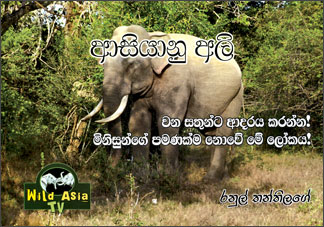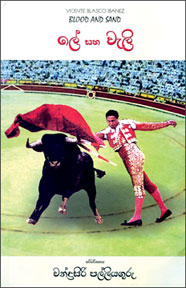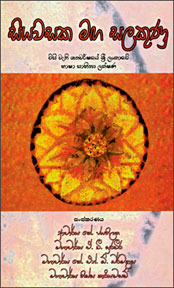BOOK REVIEWS
Child author's plea for wildlife protection
Book: 'Asianu Ali' Author: Ranul Tantilage
In my visit to the Book Fair at the BMICH, on day one, a small book,
written by a little child on a huge subject, caught my eye.
 It possessed typographical neatness. It had an easily read text, in a
flippable format. In a few pages, it gathers together a vast store of
elephant love. It possessed typographical neatness. It had an easily read text, in a
flippable format. In a few pages, it gathers together a vast store of
elephant love.
The child author has created this book, primarily for his peer-group.
But, even an adult will find the information, he presents, quite useful.
Frankly, the child-author has set down almost everything one would want
to know about the elephants.
Figures indicating the size of the elephant population worldwide,
will invariably alarm any one who loves nature.
The tiny book springs from the child's deep concern. His mind is
troubled by the fact that the elephants are an endangered species.
In the current context of elephant-man conflict, this little book is
an emotional plea to readers. The need to take steps to protect the
elephant, is quite movingly advocated here.
Though the booklet is tiny, it packs an impressive variety of facts.
An interesting feature here is an 'Asian Elephant Map', that depicts
the territories in Asia inhabited by elephants.
The production is aesthetically appealing, in its own way. Its
presence is so compelling that a child will want to take it and read it
through.
The illustrative material is quite attractive.
The language level is in the frequency of children. The usages are
simple and easily imbibed.
The underlying philosophy of this little book is quite admirable.
"Love wildlife. This world is not only for man".
A child going through this work, will without any doubt, feel
motivated to love nature.
This sentiment will mature into an affection for living things. The
tiny publication begins as a plea for the protection of the endangered
elephant.
But, its impact will extend beyond that species, to the totality of
the living world.
This is a message that the whole world needs today, in the current
context of global terrorism.
A central purpose of the Book Fair is to engender the reading habit
in the young - specifically because they tend to stray away from the
written word in preference to the electronic image and the radioed word.
This book helps to promote that ideal.
The child-author Ranul Tantilage is just 11 and is a student of the
Asian International School, Colombo.
His initial effort at authorship is an admirable little book, with a
lofty motive.
Encouraging his childish endeavour, will certainly be an impetus to
the whole generation of young ones, to be creative with a socially
beneficial urge.
- Kalakeerthi Edwin Ariyadasa
Man’s conquest of his own fears
Le saha Veli (Blood and Sand) Sangre Y Arena by Vicenthe Blasco
Ibenez
Translated by: Chandrasiri Palliyaguru Publishers: Godage and
Brothers
Vicenthe Blasco Ibenez (18620-1928) is a Spanish writer who lived in
the beginning of the past century. He wrote many books. Did many things
including founding and managing a newspaper which was censored many
times, teaching Spanish literature, being in prison, propagandising for
the Allies in World War 1, making many enemies including the Government
of his country and of course having many stormy relationships with
women.
 A colourful character no doubt, he lived only for 61 years. Died away
from his native land, in France where he lived his last years in
voluntary exile. A colourful character no doubt, he lived only for 61 years. Died away
from his native land, in France where he lived his last years in
voluntary exile.
One of his novels, Sangre Y Arena has been translated into Sinhala
from English by Chandrasiri Palliyaguru.
Made to a film twice, and to a tele series once, Blood and Sand is
about a matador - a bull fighter. In fact, Ibenez has based the story on
a real-life matador who lived in Seville,a province in Spain famous for
the game.
The experience in the book is quite alien to us Sri Lankans -
deriving pleasure by torturing and ultimately killing a defenseless
animal and playing a deadly game to overcome one’s own fear. A matador
is in constant fear of being killed by the bull. He is also in fear of
being defeated and being ridiculed by the onlookers.
Juan Gallardo or Juvannilo is a bull fighter. Once he was just a puny
urchin in rags who was constantly in hunger.
He was often beaten by his widowed mother, who wanted his little son
to follow her cobbler husband and to become a shoe maker one day. But he
would never become one.. Instead, trailing behind the bullfighters,
moving from town to town, doing all kinds of odd jobs for them he
metamorphosed into a full-fledged matador! Now that he is a man of
wealth, he treated his mother well looking into her needs, helped his
poor relatives and neighbours, married his childhood girlfriend
Carmaan Espinosa who stays faithful to him’ unto death’. Gallardo,
touring in the country with his retinue of helpers, comes in contact
with all manner of people. Among them are a murderer, rancher, collector
of all bizarre artifacts including weapons of torture in the medieval
age and a voluptuous woman of wealth and power who in some way
influences Gallardo’ mentality…When the story ends with the violent
death of Gallardo attacked by a bull, none of them but Carman was closer
to him somewhere praying in the chapel at the bull fighting arena
praying for his protection.
What is the uniqueness in Blood and Sand the translator saw as worthy
of offering it to the Sinhala reader?
‘The cultural backdrop of the story, the excellence in character
building and the imagery’ he says.
Through the novel he wishes to introduce another characteristic which
is still somewhat strange to the Sinhala novel-depiction of a dark
mysterious side of human nature - masochism/sadism in him/her. The
reader would find this nature aptly depicted in the book through the
main characters, and the people in this particular society in general.
The style of language which is faithful to the English text rich with
imagery helps convey the story with all the shades of emotions involved
in varying degrees. It is a story full of blood and gore, lust and
greed, hurt and torture of all tender emotions of love and innocence.
The early setting of the story which reeks of poverty and squalor.
squabbles of unruly men and women of hovels and slaughter houses,
gradually develops into the visuals of clamouring men and women spurred
up and angry bulls and horses running in madness, stabbed and bleeding
animals, their intestines trailing behind them. In between emerges this
sensual woman Dona Sol who overpowers the scene …. Imagery pulsates with
life.
During his lifetime Vicenthe Blasco Ibenez was reputed as the
author of best sellers. He was a prolific writer as well. Four
Horsemen of the Apocalypse - a World War 1 novel is known as his best
work. It was produced as film by Paramount Pictures in 1921 and by The
20th Century Fox films in 1941. The Blood and Sand was filmed in 1922.
- Malini Govinnage
‘Siyavasaka manga salakunu’ Highlights of a century
Editors:
Dr. K. Jayatileka
Prof. A.V.Suraweera
Prof.K.N.O.
Dharmadasa
Prof.Tissa Karyawasam
Compiled by Bobbie
Boteju & Prof.Ratnasiri
Arangala
To encapsulate the doings of a whole century into a mere 700 plus
pages is certainly an arduous and challenging task.
 Though the title (minus the more specific sub-title) misleads one
into concluding that the book encompasses the highlights of the varied
facets of activity in the island in the by-gone century it is actually
the fields of language and literature and aligned areas as drama that
form the focal venue in this text which comprises about 25 essays on
sub-topics in the area written by authorities in the area after much
research. Though the title (minus the more specific sub-title) misleads one
into concluding that the book encompasses the highlights of the varied
facets of activity in the island in the by-gone century it is actually
the fields of language and literature and aligned areas as drama that
form the focal venue in this text which comprises about 25 essays on
sub-topics in the area written by authorities in the area after much
research.
These writers having survived the toils and troubles of the war-torn
eve of the 20th Century now have made use of this work to look back on
the eclipsed century and record data in the area assigned.
This motive that has driven the editors and compilers to put out a
book of this nature is indeed a laudable one and could act as a trend
setter to many dabbling in other fields as education and archaeology.
In fact the Centenary Volume in Education has already made a debut
but published in last mid-century it excludes events of the second half
of the last century.
In the global context the dawn of the 20th Century tapering even
towards its mid-afternoon witnessed the disappearance of the sovereignty
of many a State in Afro-American and Asian continents under the heavy
boots of white man’s imperialism accompanied by the tragic end of many
native religions, languages and cultures.
A good many of them were never re-born nor resuscitated having got
miserably sucked into the parallel areas of the invader’s civilisation.
Sri Lanka was one country that withstood such fierce colonial onslaughts
to preserve its identity drawing its vigour from a strength fuelled by
Buddhism.
This text can be reckoned as one that traces the steady progress made
in language and literary fields once it decided to stay on, in the world
map political and cultural-wise.
Frankly the reviewer is one who was more or less imprisoned in the
den of formalised education while the streams of progress outlined in
this work were gushing on and it was with amazement she encountered via
this work, the hundreds of men and women who during the last 100 years
have contributed to the grand evolution. They parade through the leaves
in a bold and fantastic procession, a galaxy of self-less individuals
intent on a great mission, some now departed to the Great Beyond, some
still going on, weary but determined.
One only wishes that the language used in certain instances was more
elegant to celebrate their contribution. That in some instances the
language force weakens into a lukewarm and chaotic level should be
mentioned however as a neutral observation.
But the content matter is aptly chosen. Out of the topics dealt with
these deserve extra mention, the development of the Sinhala language
during the century, the main trends in literature, the nourishing of
indigenous literature by foreign sources, English literature born on the
soil, Tamil literature, progress of drama (Sinhala, English and Tamil),
translations, growth of fictional literature, the short story, literary
criticism, children’s literature, supplementary reading for schools and
growth of libraries.
Names of the writers of these are almost household names in many an
academically and literary-inclined family.
The editorship comprising mainly University dons, it is evident that
an attempt has been made to maintain a very high academic standard.
Sources are given at the end of each chapter while the heavy content
matter of most of essays, some running to more than 20 pages, displays
intensive reading and research as a prelude to the task of writing.
The preface itself is very thought-provoking and highlights the role
played by monks who amazingly continue to maintain their prior place in
the field of Lanka’s language and literature perpetuating memories of
those far-off days of Beminiti Saaya when they fed on leaves and roots
to preserve scriptures learnt orally.
The book is outstanding too due to its objective veneer. No
mud-slinging at persons and factions though there is a tempting platform
for such activity. No personal adulations. All data and facts are given
very objectively, in fact, sometimes too objectively and dryly.
All those who participated in the grand feat of resurgence and onward
patriotic March are mentioned though they are not adorned with florid
garlands festooned with beautiful words. Perhaps there lies the beauty
of the book as well as its dry ugliness. May be it is tough to have it
both ways.
As a side remark one gets amazed at the contribution made by certain
unsung sections of the Lankan population and also by the sometimes
disparaged Colombo elitist group to nourish facets as drama.
Perhaps they lent the support to satiate their own wish for
entertainment and enrichment of some sort but all in all the results
were starkly positive. In this light ‘Siyawasaka manga salakun’ can also
be reckoned as an ode to the linking of the different communities in the
island to bring back and push ahead the cultural enrichment of the
island via the fields of language, literature, and drama now nourished
by foreign forces too, subsequent to a long period of dormancy teetering
towards a total end.
Interspersed with periods of intense civil warfare and foreign
invasions the decadence that set in intensified itself during three
regimes of colonial powers.
The book is further highly informative and lifting the curtain on
many a hitherto cloistered area is a MUST for public libraries plus
institutes of higher learning Translations of the text could be ventured
into for the information of those not acquainted with Sinhala.
Further could be tried out the previously mentioned suggestion to
record the progress made in this highly vital century in different areas
when tables in the world turned with a vengeance or to put it more
mildly, with a firm resolution to preserve the vivid and myriad aspects
of the world and its wealth of people.
Padma Edirisinghe |

